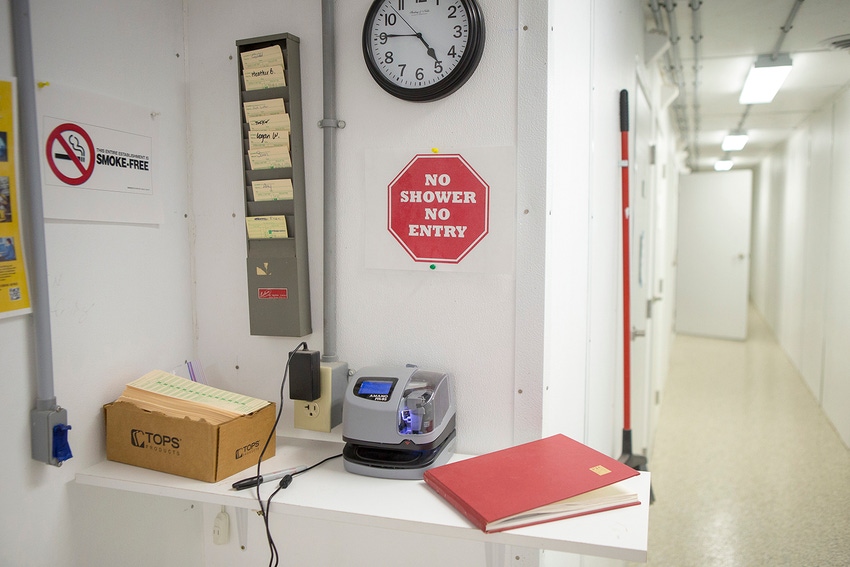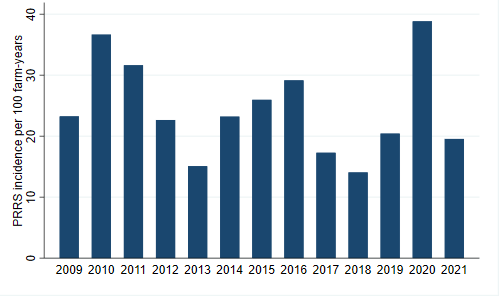How long can my sow herd remain free of PRRSV?
Location, regional pig density, general biosecurity practices and air filtration all need to be considered.
January 9, 2024

By Mariana Kikuti, Catalina Picasso-Risso, Claudio Marcello Melini and Cesar A Corzo, University of Minnesota College of Veterinary Medicine
Porcine reproductive and respiratory syndrome remains a significant challenge for the U.S. swine industry. In some instances, PRRS elimination has been successfully achieved through depopulation and repopulation, a costly yet effective method. Another approach involves herd closure, which, although less expensive, can be a prolonged and uncertain process, often requiring between 35-50 weeks for herds to consistently produce virus-free piglets following intervention [1].
We used data from the Morrison Swine Health Monitoring Project, a Swine Health Information Center-funded initiative wherein U.S.-based production systems voluntarily share their breeding herd health status on a weekly basis. Breeding herd PRRSV data from July 2009 to October 2021 were classified according to the American Association of Swine Veterinarians PRRS breeding herd guidelines, including positive unstable (Status 1), positive stable (Status 2 – stable without vaccination or gilt exposure, Status 2vx – stable with ongoing vaccination, Status 2fvi – stable with ongoing gilt field virus exposure), provisional negative (Status 3), or negative/seronegative/naïve (Status 4) [3].
Overall, 221 herds eliminated PRRSV and achieved Status 4 on 273 occasions. Among these, 48 herds transitioned from Status 1, 167 from Status 2, 30 from Status 2fvi, 20 from Status 2vx, and 8 from Status 3. When examining the annual number of herds reaching Status 4, it ranged from 3 in 2009 to 35 in 2014, with an average of 21 herds annually.
The median duration that breeding herds maintained Status 4 post-virus elimination was almost two years (i.e., 728 days, with an Interquartile range of 280–1281 days) and ranged between seven days and 10 years before transitioning to a different status or the end of the study period. In 91 out of 273 cases, herds successfully maintained Status 4 until the study period's end, while in 163 cases (59.71%), herds eventually lost this status due to wild-type virus introduction. On 15 occasions, herds shifted from Status 4 to Status 2vx, likely due to a strategic decision by the herd veterinarian. When looking at sites that transitioned from Status 4 to Status 1, the median time in Status 4 was 1.6 years (602 days, Interquartile range 259–1050 days), meaning these herds were able to wean seronegative/virus-free piglets for approximately 83 weeks.
Another aspect of the analysis involved calculating the occurrence of PRRSV in Status 4 farms using the incidence rate. After taking production system into account, the overall incidence rate was 23.43 PRRS outbreaks per 100 farm-years which can also be interpreted that in a given year, 23 herds out of 100 will report a break. Incidence rate according to the year in which the site first achieved Status 4 is shown in Figure 1.

UMN. Figure 1. PRRS incidence rate per 100 farm years by year in which sites became naïve.
Status 4 sites located in the Northeast and South were shown to have 25% and 31% of the risk for a PRRS introduction than the Midwest Status 4 sites. However, here, time to PRRS introduction was only assessed in farms that had reached a naïve status.
Breeding herds that had opted to pursue a naïve status are likely different from those that opt to endure at positive stable statuses in terms of location, regional pig density and general biosecurity practices. That, together with the different regional distribution of sites that achieve Status 4 compared to sites that never achieve Status 4, combined with the perceived risk of investing in air filtration, likely explain this difference. In fact, all of the sites that achieved Status 4 were either partially or year-round filtered were from the Midwest.
While the production system was accounted for in our statistical model, the inherent heterogeneity of other factors such as PRRS prevention, control and elimination philosophy affecting transmission and heterogeneity of production systems distribution might not have been captured.
Although our study did not delve into factors like decision-making processes for pursuing Status 4 and additional biosecurity practices, among others, which could impact the duration in Status 4 and the PRRS incidence rate, it provides valuable insights into how frequently sites strive for elimination and how long they can maintain a naïve status. The continued pursuit of Status 4 by companies indicates perceived benefits at the herd welfare, health and financial levels.
Authors would like to acknowledge MSHMP participating companies, swine veterinary clinics and practitioners for their willingness to share their data. We also would like to acknowledge SHIC for financially supporting MSHMP.
References
Sanhueza J, Vilalta C, Corzo C, Arruda A. Factors affecting Porcine Reproductive and Respiratory Syndrome virus time-to-stability in breeding herds in the Midwestern United States. Transbound Emerg Dis. 2018;Dec 6. doi:10.1111/tbed.13091
Kikuti M, Picasso-Risso C, Melini CM, Corzo CA. Time Farms Stay Naïve for Porcine Reproductive and Respiratory Syndrome. Animals (Basel). 2023 Jan 16;13(2):310. doi: 10.3390/ani13020310. PMID: 36670849; PMCID: PMC9854491.
Holtkamp DJ, Polson DD, Torremorell M, Morrison B, Classen DM, Becton L, et al. Terminology for classifying swine herds by porcine reproductive and respiratory syndrome virus status. J Swine Heal Prod. 2011;19: 44–56.
You May Also Like



